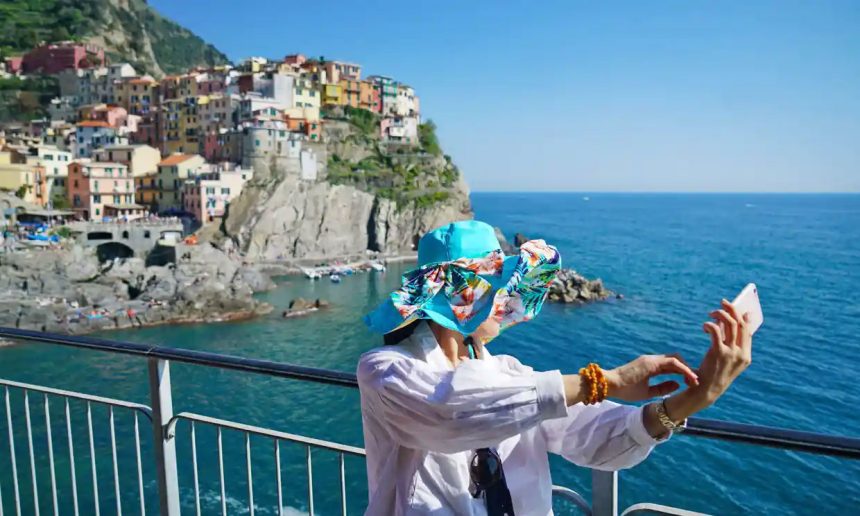ast week Italy was, again, struggling with the conundrum of mass tourism. One of the country’s most charming seaside towns, Portofino, has just introduced legislation to dissuade tourists lingering for selfies: there will be fines of up to €275 (£243) if they block traffic or pedestrians in two “red zones” of the beautiful bay.
It’s the latest in a series of draconian measures adopted by Italian councils to deal with herds of holidaymakers: there are fines of up to €2,500 for walking the paths above the Cinque Terre (five villages in Liguria) in flip-flops or sandals; you are no longer allowed to eat snacks outside in the centre of Venice or in four central streets in Florence; you can be fined €250 just for sitting down on Rome’s Spanish Steps; and one beach, in Eraclea, has even banned the building of sandcastles (maximum fine €250) because they’re considered unnecessary obstructions.
Italy, of course, more or less invented the concept of tourism: as a cradle of ancient civilisation and Renaissance splendour, the peninsula became de rigueur for aesthetes and aristocrats. The famous “Grand Tour” was born in the 17th century and ever since then tourism has been vital to the Italian economy: pre-Covid, the country received 65 million visitors a year and, according to the Bank of Italy, tourism (considered in the widest sense) represented 13% of the country’s GDP.
But Italy, so dependent on tourism, is also beginning to despair of it. Last week, a new display was introduced in a bookshop in Venice that reveals, painfully and in real time, the number of beds available in the city to tourists: at 48,596 (and counting), it is perilously close to overtaking the number of residents in the city: 49,365 (and falling). As recently as 2008, the respective figures were 12,000 and 60,000.

So a city that is famously concerned about drowning in water is now more fretful about drowning in humans. In January, Venice even introduced an entrance fee (varying between €3 and €10) to access the city and its islands. The move wasn’t controversial because it monetised tourism – that has always happened – but because it made the city appear precisely what it is trying to avoid becoming: a theme park, a time capsule for gawking, snap-happy visitors, more a relic than actually alive.
The problem is that mass tourism is turning destinations into the opposite of what they once were. The attraction of the Cinque Terre is their stunning simplicity: they have no great monuments as such, neither grand cathedrals nor castles, just a sense of serenity, of human ingenuity and topographical grandeur (the steep mountains, terraced and criss-crossed by paths where possible, host pastel houses perched above an azure sea).
But the serenity and simplicity can’t survive millions of wham-bam visitors a year. Two weeks ago, Fabrizia Pecunia, the mayor of one of the five villages, Riomaggiore, complained: “It’s no longer possible to postpone the debate about how to handle tourist flows. If we don’t [find a solution], our days as a tourist destination are numbered.” What tourist hot spots most yearned for a decade or two ago – high numbers, influx and flows – is precisely what is now causing them problems. During the peak season, the Balearic island of Mallorca now has more than 1,000 flights landing every day.
The World Tourism Organization predicts that by the end of this decade the flow of international tourists will surpass 2 billion. What’s called “overtourism” is already so acute that popular destinations are now doing the unthinkable, and actively trying to dissuade or block arrivals. Last month, Amsterdam launched “stay away” ads aimed at badly behaved Brits. The Greek island of Santorini, a mere 29 square miles, had to cap cruise ship passengers to 8,000 a day in 2017. Venice has blocked cruise ships and, in 2012, the anti-tourism message proved a winning formula for a mayoral candidate in Barcelona.
Now the road is so designated that you feel forced through a well-oiled funnel as someone picks your pockets
But if the tourism boom is often bad for locals, it’s equally depressing for visitors. The fiction of tourism in the social media age is that we, as rugged adventurers, are there by ourselves. But we’re only alone for that Instagram money shot. The rest is full of crowds and discomfort. When a friend of mine foolishly went to the Cinque Terre at Easter, there were long queues just to get on the footpaths or to drink a coffee. She then had to queue for three hours just to board one of the rickety trains home.
Anyone who has been to Niagara Falls, say, or Stonehenge knows that natural or human wonders have been mercilessly monetised. It now costs, for example, €34 to visit the Angkor Wat temple in Cambodia. Visitors to famous sites often come away feeling not uplifted, but fleeced by car-park charges, entry prices, food stalls and so on. We’re bemused by the inauthenticity of the experience. Travel used to be about adventure and hardship, sometimes solitude, but invariably surprise and spontaneity. Now the road is so well-trodden and designated that you feel forced through a well-oiled funnel as someone picks your pockets.
But the sense of unease goes deeper. In the past we travelled to broaden and educate the mind. Travellers suffered discomfort – a mule over the Alps, a clipper across the Bay of Biscay – to absorb the wideness of the world, to feel small or vulnerable perhaps, and to allow the learning of other cultures to infiltrate their beings. Now, it seems, all that is reversed: there’s minimal danger or risk to travel, and our big egos are imposed on a small world. Sites are nothing more than the backdrop for our selfies because we go places not to learn from them, but just to post and boast to others that we’ve been there.
Tobias Jones lives in Parma. His latest book is The Po: An Elegy for Italy’s Longest River
Do you have an opinion on the issues raised in this article? If you would like to submit a letter of up to 250 words to be considered for publication, email it to us at observer.letters@observer.co.uk
… as 2023 gathers pace, and you’re joining us from Pakistan, we have a small favour to ask. A new year means new opportunities, and we’re hoping this year gives rise to some much-needed stability and progress. Whatever happens, the Guardian will be there, providing clarity and fearless, independent reporting from around the world, 24/7.
Times are tough, and we know not everyone is in a position to pay for news. But as we’re reader-funded, we rely on the ongoing generosity of those who can afford it. This vital support means millions can continue to read reliable reporting on the events shaping our world. Will you invest in the Guardian this year?
Unlike many others, we have no billionaire owner, meaning we can fearlessly chase the truth and report it with integrity. 2023 will be no different; we will work with trademark determination and passion to bring you journalism that’s always free from commercial or political interference. No one edits our editor or diverts our attention from what’s most important.
With your support, we’ll continue to keep Guardian journalism open and free for everyone to read. When access to information is made equal, greater numbers of people can understand global events and their impact on people and communities. Together, we can demand better from the powerful and fight for democracy.
Whether you give a little or a lot, your funding will power our reporting for the years to come. If you can, please support us on a monthly basis from just $2. It takes less than a minute to set up, and you can rest assured that you’re making a big impact every single month in support of open, independent journalism. Thank you.

